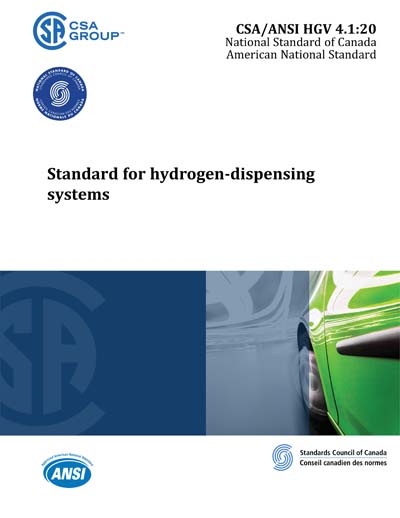Most recent
CSA/ANSI HGV 4.1-2020
Hydrogen-dispensing systems
Preface This is the second edition of CSA/ANSI HGV 4.1, Hydrogen dispensing systems. It supersedes the previous edition published in 2013. This edition of CSA/ANSI HGV 4.1 harmonizes with other North American requirements, including those referenced in the Canadian Hydrogen Installation Code. Additional changes to this edition include alignment with CSA HGV 4.9, Standard for hydrogen fuelling stations, and the addition of Annex A. This Standard represents a standard for safe operation, substantial and durable construction, and performance testing of the mechanical and electrical features of newly manufactured hydrogen gas- dispensing systems for vehicles, intended primarily to dispense fuel directly into the vehicle fuel storage container. This Standard is based on engineering principles, research, and the combined expertise of manufacturers, users, and others having specialized experience. Nothing in this Standard is to be considered in any way as indicating a measure of quality beyond compliance with the provisions it contains. It is designed to allow compliance of products that may exceed that specified in the provisions herein. In its preparation, full recognition has been given to possibilities of improvement through ingenuity of design. This Standard is subject to revision as further experience and investigation might show that it is necessary and desirable. CSA Group acknowledges that the development of this Standard was made possible, in part, by the financial support of Natural Resources Canada. This Standard has been developed in compliance with Standards Council of Canada requirements for National Standards of Canada. It has been published as a National Standard of Canada by CSA Group. This Standard has been approved by the American National Standards Institute (ANSI) as an American National Standard. Scope 1.1 This Standard specifies mechanical and electrical requirements for dispensers of compressed hydrogen gas intended for fuel storage systems integral to fuel cell vehicles at pressures of 25, 35, 50, and 70 MPa. Dispensing systems covered by this Standard include a) HGV dispensers that integrate all dispensing system components in a single unit, including fuel metering and registering, flow control and safety management devices, heat exchangers, and vehicle fuel cylinder over-fill and over-pressure protection with listed hoses with nozzles (see Figure A.1); or b) HGV dispensers that are primarily the customer facing unit with fueling hose assembly listed hoses, nozzles, and operator interface, and where the key components of flow metering and over- pressure and over-fill protection are located in a separate unit or part of the hydrogen fuelling station system (see Figure A.2). The following service pressures are applicable: 25, 35, 50, and 70 MPa. Each dispensing system could have multiple valve trains allowing fuelling of multiple vehicles. 1.2 Dispensing systems covered by this Standard are intended for use with fuel meeting the requirements in SAE J2719 and ISO 14687-2. 1.3 This Standard applies to dispensers that protect the vehicle storage for over-pressure, over- temperature, and over-fill (i.e., over-density) situations. 1.4 This Standard also applies to dispensing systems that are part of a modular fuelling station with remote fuel metering, registering, control and management devices, and vehicle fuel storage over-fill and over-pressure protection included in an integrated fuelling station control system. For these applications, refer to CSA HGV 4.9. 1.5 This Standard does not apply to dispensers intended for the refueling of hydrogen-powered industrial trucks. Note: CSA HPIT 2 addresses dispensers intended for the refuelling of hydrogen-powered industrial trucks. 1.6 All references to pressure throughout this document Standard are to be considered gauge pressures unless otherwise specified in this Standard. 1.7 These requirements are not intended to prevent the design and construction of a dispensing system not specifically prescribed in this Standard. In considering alternative designs or construction, the materials used shall be evaluated as to their ability to yield equivalent performance to that prescribed by this Standard. 1.8 In this Standard, "shall" is used to express a requirement, i.e., a provision that the user is obliged to satisfy in order to comply with the standard; "should" is used to express a recommendation or that which is advised but not required; "may" is used to express an option or that which is permissible within the limits of the standard; and "can" is used to express possibility or capability. Notes accompanying clauses do not include requirements or alternative requirements; the purpose of a note accompanying a clause is to separate from the text explanatory or informative material. Notes to tables and figures are considered part of the table or figure and may be written as requirements. Annexes are designated normative (mandatory) or informative (non-mandatory) to define their application. 1.9 The values given in SI units are the units of record for the purposes of this Standard. The values given in parentheses are for information and comparison only.
Content Provider
CSA America, Inc. [csa]






